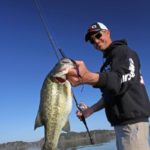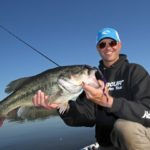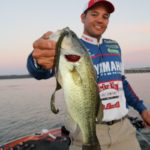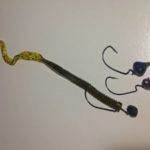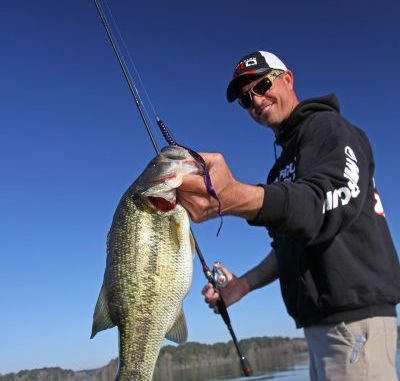
When fish transition to their summer haunts, jumbo worms can be the key to convincing big fish to feed. Here’s how the pros use them to build limits.
He’s not the fastest guy on the court, nor is he the flashiest. The center, the big man in the middle, has certain responsibilities, and when called on for particular duties, that size and strength play to his advantage
The same is true of a big worm in the bass-fishing game.
By “big,” we usually mean something in that 10-plus-inch range like the Strike King Anaconda, Zoom Old Monster, YUM Mighty Worm, Trigger Hammer Worm, Berkley Power Worm, Kickerfish Hightail, Gambler ER16 or Yamamota Curly Tail.
You’re not going to see these bulky baits on drop shots or shaky heads, as other options fit those finesse presentations.
Rather, the big worm is more of a power player — one that gets in fish’s faces, makes its presence known and flips switches that the tiny stuff might not.
Let’s consider the time of year and what bass are doing. With the spawn behind them, many of the fish are transitioning from their postspawn staging areas to their summer haunts.
Bassmaster Elite Series pro Dennis Tietje said this is the time of year when the numbers game can work in your favor.
“In June, bass are starting to bunch up and feed,” he said. “The big worms can be very productive for big fish.”
Indeed, consider the combination of feeding competition and overall summer lethargy. This means that, while bass would rather sit somewhere cool and deep and gobble the occasional hefty meal, theirs is a swift response to the appearance of such offerings.
Like most bait categories, big worms come in several different designs, but Tietje recommended keeping it simple.
We don’t want to oversimplify, but for the sake of this discussion, he pointed to straight-tail and ribbon-tail designs.
The latter’s known for creating more motion to attract fish in cover, while the subtlety of the former serves well when the fish are pressured or clear water makes them edgy.
Here’s a look at Tietje’s favorite tactics for the lanky plastics:
• Punching — The setup includes a ¾-ounce weight, 30-pound braided line and a 10-inch ribbontail.
This is Tietje’s favored big-worm technique, and it’s all about driving that lanky bait through hydrilla or weed mats to irritate bass below with a large profile intruder.
• Casting — The Bassmater Elite Series pro uses a ¼-ounce weight, 20-pound fluorocarbon and a 10-inch mag ribbontail when he’s tossing the big plastics.
His presentation in this instance involves slowly dragging the lure across main-lake points.
• Carolina rig — This outfit includes a ¾-ounce weight, a 2- to 3-foot leader, a 5/0 extra wide-gap hook, 20-pound fluorocarbon and an 11-inch straight-tail finesse worm.
No surprise, Tietje moves the worm along with sweeping pulls over points and ridge tops.
June bug and plum apple are his favorite colors for all three of these approaches.
A multi-faceted player, the big worm can take on several other roles, each relying on that plastic mass for bass impression.
On Toledo Bend, Stephen Johnston’s a fan of slithering a big Texas-rigged worm across the top of deep hydrilla, mimicking a small snake traversing the vegetation.
A straight tail will get the job done, but a ribbontail affords you that enticing rippled motion when you bring your worm across open areas in the weeds.
“They’ll blow right through that grass to get that worm,” Johnston said.
FLW Tour pro Larry Nixon’s on that deal, as well.
He also likes a big worm around lily pads, where he fits his 12-inch Yamamoto Curly Tail Worm with a ¼-ounce bullet weight. That little punch on the lure’s nose helps his bait push through the broader vegetation and instantly convert to a flipping presentation if he wants to drop that worm into a shadowy hole.
When the deep crankbait bite slows, FLW Tour pro David Dudley switches to a 10-inch worm to clean up the area.
He’ll rig a ribbon-tail and a straight-tail worm on a football head and mop up a few more bites with a big target that rumbles across the bottom with less imposition than a crankbait.
Bassmaster Classic champion Casey Ashley said he fishes a Zoom Old Monster Texas-rigged with a 5/16-ounce weight and a 5/0 Gamakatsu round-bend hook about 90 percent of the time, but he also entertains creative options.
He’s fond of this bait for offshore structure and, like Dudley, he knows the value of giving the fish a different look.
“A big worm also works well on a swing-head jig,” Ashley noted. “It acts kind of like a football-head jig with a bigger profile.
“You can actually cover a lot more water with (a big worm on a swing head). You just throw it out there, and it’s kind of like slow rolling a spinnerbait. You just crawl it on the bottom.”
Ashley said one of the key benefits of this presentation is that it puts a novel spin on a proven technique — dragging a football-head jig. When fishing pressure’s high and the fish are seeing a lot of standard football-head packages with craws and creature baits, a swing head and big worm is a real head-turner.
“It’s a worm presentation, but you can cover a lot more water with it,” Ashley said. “You can wind a (standard) football head, but you have to wind it more slowly because (traditional trailers) are so bulky they want to lift up off the bottom.
“But when you put that worm on that swing head, you have the same presentation as a football head but you have a slimmer profile, but a big bait.
“It’s kind of the best of both worlds.”
For brush piles, Ashley said he has to Texas-rig his worm, but offshore cranking sites like the humps, ridges and points of Toledo Bend, Pickwick Lake or Ross Barnett Reservoir make dandy theaters for letting that swing head boogie across the bottom.
